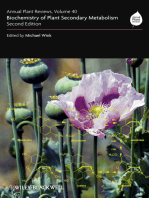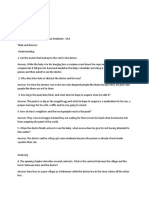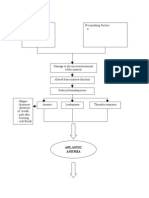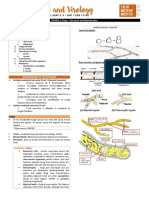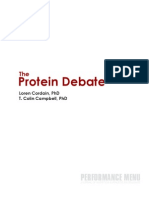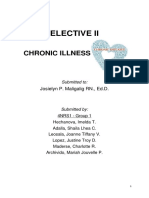0 ratings0% found this document useful (0 votes)
32 viewsPlant Form and Function
Plant Form and Function
Uploaded by
Mae MejaresThis document provides an overview of plant form and function, including plant growth and development, transport systems, nutrition, hormones, reproduction, and modern biotechnology applications. It discusses the key elements and functions for plant nutrition, such as carbon, hydrogen, oxygen, boron, calcium, and others. The transport system in plants, specifically the phloem, is also mentioned. Modern biotechnology techniques that have aided plant breeding and mass production include plant tissue culture, genetic engineering, and tools like site-specific integration and multigene transfer.
Copyright:
© All Rights Reserved
Available Formats
Download as PPTX, PDF, TXT or read online from Scribd
Plant Form and Function
Plant Form and Function
Uploaded by
Mae Mejares0 ratings0% found this document useful (0 votes)
32 views43 pagesThis document provides an overview of plant form and function, including plant growth and development, transport systems, nutrition, hormones, reproduction, and modern biotechnology applications. It discusses the key elements and functions for plant nutrition, such as carbon, hydrogen, oxygen, boron, calcium, and others. The transport system in plants, specifically the phloem, is also mentioned. Modern biotechnology techniques that have aided plant breeding and mass production include plant tissue culture, genetic engineering, and tools like site-specific integration and multigene transfer.
Original Description:
Report
Original Title
Biology Report
Copyright
© © All Rights Reserved
Available Formats
PPTX, PDF, TXT or read online from Scribd
Share this document
Did you find this document useful?
Is this content inappropriate?
This document provides an overview of plant form and function, including plant growth and development, transport systems, nutrition, hormones, reproduction, and modern biotechnology applications. It discusses the key elements and functions for plant nutrition, such as carbon, hydrogen, oxygen, boron, calcium, and others. The transport system in plants, specifically the phloem, is also mentioned. Modern biotechnology techniques that have aided plant breeding and mass production include plant tissue culture, genetic engineering, and tools like site-specific integration and multigene transfer.
Copyright:
© All Rights Reserved
Available Formats
Download as PPTX, PDF, TXT or read online from Scribd
Download as pptx, pdf, or txt
0 ratings0% found this document useful (0 votes)
32 views43 pagesPlant Form and Function
Plant Form and Function
Uploaded by
Mae MejaresThis document provides an overview of plant form and function, including plant growth and development, transport systems, nutrition, hormones, reproduction, and modern biotechnology applications. It discusses the key elements and functions for plant nutrition, such as carbon, hydrogen, oxygen, boron, calcium, and others. The transport system in plants, specifically the phloem, is also mentioned. Modern biotechnology techniques that have aided plant breeding and mass production include plant tissue culture, genetic engineering, and tools like site-specific integration and multigene transfer.
Copyright:
© All Rights Reserved
Available Formats
Download as PPTX, PDF, TXT or read online from Scribd
Download as pptx, pdf, or txt
You are on page 1of 43
CHAPTER 1
Plant Form and Function
PLANT GROWTH AND DEVELOPMENT
Plant growth, from seed
germination to maturity, involves a
combination of cellular responses
and molecular interaction
Transport System in
Plants
The Phloem....
Plant Nutrition
When we talk about plant nutrition,we
are referring to the supply and absortion
of chemical compounds for the growth
and metabolism of plants.In order for
higher plants to sustain their metabolic
processes,inorganic nutrients are
obtained from the environment via
soil,air and water.
Elements Function in plants
Carbon, Hydrogen, oxygen Major constituent of organic plant material;
assimilation of oxidation – reduction reactions
Boron Cell wall synthesis; enzymatic reactions and
metabolic pathways; mitotic activity for root
development
Calcium Structural component of the cell wall and cell
membrane; counter ion in the vacuole
Chlorine Water splitting system for photosystem II;
stomatal opening regulation
Copper Co – factor for metalloproteins and enzymes;
photosynthetic electron transport; cell wall metabolism
and hormone signaling; oxidative stress response
Iron Regulatory component of proteins and metabolities in roots
and leaves
Magnesium Chloropyll synthesis; cofactor in activation of ATPase
Manganese Photodestruction of chloropyll and chloroplast structure;
enzyme activator; precursor of amino acid,
hormones(auxins) and lignins
Molybdenum Enzyme activation(e.g nitrate reductase, catalase, and
ribonuclease); chloropyll synthesis
Nickel Endosperm development and dehydrogenase activity; urease
activation for urea breakdown; root nodule growth
Nitrogen General plant growth of roots, stem, leaf, flowers and fruits;
chloropyll synthesis
phosphorus Energy transferring process for photosynthesis and respiration (ADP-
ATP synthesis); structural component of phospholipids, nucleic acids,
coenzymes, and nucleotides
Potassium Cell extension and stomatal regulation; enzyme,activation (kinase,
starch synthase, and nitrate reductase); photosynthetic activity(e.g.,
CO2 fixation and PH regulation)
SULFUR Assimilation of oxidation – reduction reactions; participates in various
enzymatic processes
Zinc Enzymatic function and reactivity; stem elongation; protein and
starch synthesis
Plant Hormones,Responses
and Feedback Mechanism
Reproduction and Modern
Biotechnological Application
Biotechnology has advance
significantly over the previous
years that breeding crops and
mass production are now aided
by plant tissue culture and
molecular biology techniques
Genetic engineering in plants was
introduced in the 1980's to create
transgenic crops that are high-yield and
persistant. This technology utilizes
Agrobacterium tumefaciens to randomly
introduced heterologous DNA into
plants,thereby directly manipulating the
regulatory elements or expression of
endogenous.
Modern biotechnological tools applied
to plants are site-specific integration,
multigene transfer, and regulations of
Gene expression to improve crop yeild
and resistance.
Thank you for
listening!
Reported by: Mejares, Mae Antonette P.
You might also like
- Modern Blood Banking Transfusion Practices 5th Ed. by Denise HarmeningDocument568 pagesModern Blood Banking Transfusion Practices 5th Ed. by Denise HarmeningFarah TayyabNo ratings yet
- Synoptic Essay PlansDocument21 pagesSynoptic Essay PlansBio_Joe50% (2)
- Plant Form and FunctionDocument42 pagesPlant Form and FunctionSharmine Poligratis RicoNo ratings yet
- Plant NutritionDocument15 pagesPlant NutritionamieljihnNo ratings yet
- GEN. BIO. 2 Q4 Wk2A MENDELSSOHN L. AJESTA IIDocument12 pagesGEN. BIO. 2 Q4 Wk2A MENDELSSOHN L. AJESTA IIJohn Paul Luzgano AganapNo ratings yet
- Lec. 01.introductionDocument43 pagesLec. 01.introduction6ng2q6xywwNo ratings yet
- Liceo de Cagayan University School of Graduate StudiesDocument25 pagesLiceo de Cagayan University School of Graduate StudiesKristoffer VillarealNo ratings yet
- Lec. 01.introductionDocument43 pagesLec. 01.introductionNivedhaNo ratings yet
- Plant Physiological ResponsesDocument9 pagesPlant Physiological Responsessalceda.ricamae123No ratings yet
- GB2 Q4 Week-2a For StudentsDocument7 pagesGB2 Q4 Week-2a For Students2bdmd3No ratings yet
- B Ca CL Cu Fe MG MN Mo Ni: Carbon, Hydrogen, Oxygen BoronDocument4 pagesB Ca CL Cu Fe MG MN Mo Ni: Carbon, Hydrogen, Oxygen BoronWayne SalvadorNo ratings yet
- 11 Biology Notes Ch12 Mineral NutritionDocument5 pages11 Biology Notes Ch12 Mineral NutritionTushar RajNo ratings yet
- Plant Growth and DevtDocument38 pagesPlant Growth and DevtPatriciaNo ratings yet
- Biochemistry2 PapersDocument31 pagesBiochemistry2 PapersShamoon HaroonNo ratings yet
- 10 Homeostasis in Plant CellDocument47 pages10 Homeostasis in Plant CellMaleeha BasharatNo ratings yet
- 1186Document7 pages1186Jehan Carlos Saldarriaga RuizNo ratings yet
- (1422) Higher Biology Key Facts - All UnitsDocument8 pages(1422) Higher Biology Key Facts - All UnitsjayasinghethulanNo ratings yet
- 3 PTC Medium-1Document34 pages3 PTC Medium-1HARSH MEENANo ratings yet
- Unit I - BSWDocument25 pagesUnit I - BSWRitesh DavkareNo ratings yet
- Chapter 12 - Mineral NutritionDocument8 pagesChapter 12 - Mineral NutritionShani KumarNo ratings yet
- Essay Titles + MarkschemesDocument49 pagesEssay Titles + MarkschemesSairah RazakNo ratings yet
- Biochemistry2 Past PaperDocument36 pagesBiochemistry2 Past PaperShamoon HaroonNo ratings yet
- Soil Microbiology NoteDocument21 pagesSoil Microbiology NoteOluwakemi OyinloyeNo ratings yet
- What Are The Functions of Each of These Nutrients in PlantsDocument4 pagesWhat Are The Functions of Each of These Nutrients in PlantsEula YaoNo ratings yet
- Proteome Analysis of Wheat (Triticum Aestivum L.) Root Under Sodium Chloride StressDocument12 pagesProteome Analysis of Wheat (Triticum Aestivum L.) Root Under Sodium Chloride StressMd Ashikur RahmanNo ratings yet
- Adati SeminarDocument10 pagesAdati SeminarSajo Muhammad SalehNo ratings yet
- InTech-Plant Genes For Abiotic StressDocument27 pagesInTech-Plant Genes For Abiotic StressJan Crezul BalodongNo ratings yet
- Soil Science LectureDocument83 pagesSoil Science LectureMadellane MichaelisNo ratings yet
- Plants and Environment Factors - The PlantDocument33 pagesPlants and Environment Factors - The PlantnuningNo ratings yet
- Nutrition: Animation 8.1: Nutrition Source & Credit: WikispaceDocument43 pagesNutrition: Animation 8.1: Nutrition Source & Credit: WikispaceAaa SssNo ratings yet
- Plants and Environment Factors-2020Document39 pagesPlants and Environment Factors-2020Angeline CallistaNo ratings yet
- Photosynthesis Biology G10Document10 pagesPhotosynthesis Biology G10nurainnnNo ratings yet
- Plants and their PhotosynthesisDocument4 pagesPlants and their PhotosynthesisAyeza MaqsoodNo ratings yet
- Lecture 2B Plant NutrientDocument39 pagesLecture 2B Plant NutrientFarah ReginaNo ratings yet
- Fertilizer Management For Greenhouse VegetablesDocument19 pagesFertilizer Management For Greenhouse VegetablesMentewab EthiopiaNo ratings yet
- s44279-024-00070-xDocument13 pagess44279-024-00070-xehab IbrahemNo ratings yet
- Annual Plant Reviews, Biochemistry of Plant Secondary MetabolismFrom EverandAnnual Plant Reviews, Biochemistry of Plant Secondary MetabolismNo ratings yet
- Molecular Biology of Drought StressDocument34 pagesMolecular Biology of Drought Stressvarsha pNo ratings yet
- Plants and Environment Factors - The PlantDocument33 pagesPlants and Environment Factors - The PlantRania PrastiwiNo ratings yet
- 6.1 PhotosynthesisDocument49 pages6.1 PhotosynthesisDea TjahyadiNo ratings yet
- DBT-JRF BET Part B Agricultural Biotechnology PDFDocument3 pagesDBT-JRF BET Part B Agricultural Biotechnology PDFambu100% (2)
- 28 Life Science-711eda53Document9 pages28 Life Science-711eda53praveenkumarpk78470No ratings yet
- Essay On Photosynthesis 12000 WordsDocument7 pagesEssay On Photosynthesis 12000 WordssyedashahworkNo ratings yet
- 2007 Trace Element Water Improves The Antioxidant Activity of Buckwheat (Fagopyrum Esculentum Moench) SproutsDocument7 pages2007 Trace Element Water Improves The Antioxidant Activity of Buckwheat (Fagopyrum Esculentum Moench) Sproutsdenisa9525No ratings yet
- Unit 2 ClassnotesDocument52 pagesUnit 2 ClassnotesYASH WANKHEDENo ratings yet
- Polyphenols Methods of ExtractionDocument6 pagesPolyphenols Methods of ExtractionWidayat WahyuNo ratings yet
- Physiological and Proteomic Analysis of Maize Seedling Response To Water Deficiency StressDocument10 pagesPhysiological and Proteomic Analysis of Maize Seedling Response To Water Deficiency StressasricahyaningpamujiNo ratings yet
- Signal Transduction Pathways Under Abiotic StresseDocument11 pagesSignal Transduction Pathways Under Abiotic StresseEtt IsMailNo ratings yet
- Jam ABC Dec2008Document9 pagesJam ABC Dec2008pazrroNo ratings yet
- Application of The Synechococcus NirA Promoter ToDocument8 pagesApplication of The Synechococcus NirA Promoter ToEduardo MoreiraNo ratings yet
- PDFgen I4yfmcdqlnvequfp4eixpeq0Document1 pagePDFgen I4yfmcdqlnvequfp4eixpeq0hanive3226No ratings yet
- Nutritional Requirements of BacteriaDocument25 pagesNutritional Requirements of BacteriaAira Miya100% (1)
- Syllabus For Agriculture and Medical Subject: Botany: Ap EamcetDocument19 pagesSyllabus For Agriculture and Medical Subject: Botany: Ap EamcetJagannath MavuduriNo ratings yet
- Fundamentals of Plant Biochemistry and Biotechnology PDFDocument215 pagesFundamentals of Plant Biochemistry and Biotechnology PDFtinkusagar2005No ratings yet
- ScienceDocument15 pagesScienceVijayakumarNo ratings yet
- REPORTING BiochemistryDocument6 pagesREPORTING Biochemistryclent girayNo ratings yet
- Drought Tolerance: Potential Due To High Solute ConcentrationDocument12 pagesDrought Tolerance: Potential Due To High Solute ConcentrationMudit MisraNo ratings yet
- Soil Fertility and ManagementDocument61 pagesSoil Fertility and ManagementAngge Cortes100% (1)
- Overview Mega E3afaDocument19 pagesOverview Mega E3afaVolodymyrNo ratings yet
- Introduction-To-Photosynthesis - PDF 20240318 013116 0000Document9 pagesIntroduction-To-Photosynthesis - PDF 20240318 013116 0000alim syah digyadanaNo ratings yet
- Photosynthesis: A New Approach to the Molecular, Cellular, and Organismal LevelsFrom EverandPhotosynthesis: A New Approach to the Molecular, Cellular, and Organismal LevelsSuleyman I. AllakhverdievNo ratings yet
- FS 12 Parents Consent 2023Document3 pagesFS 12 Parents Consent 2023Mae MejaresNo ratings yet
- FS 1Document10 pagesFS 1Mae MejaresNo ratings yet
- 5as Lesson Plan MapehDocument4 pages5as Lesson Plan MapehMae MejaresNo ratings yet
- TTL DemoDocument9 pagesTTL DemoMae MejaresNo ratings yet
- A Detailed Lesson Plan in English Special FinalDocument11 pagesA Detailed Lesson Plan in English Special FinalMae MejaresNo ratings yet
- Chapter 3Document13 pagesChapter 3Mae MejaresNo ratings yet
- The PearlDocument4 pagesThe PearlMae MejaresNo ratings yet
- A - Detailed - Lesson - Plan - in - English - For - Grade - 7 FinaleDocument11 pagesA - Detailed - Lesson - Plan - in - English - For - Grade - 7 FinaleMae MejaresNo ratings yet
- Answers Key: Justiniana Edera, San Jose, Dinagat IslandsDocument2 pagesAnswers Key: Justiniana Edera, San Jose, Dinagat IslandsMae MejaresNo ratings yet
- Assessment of Learning 1Document60 pagesAssessment of Learning 1Mae MejaresNo ratings yet
- Three Days To SeeDocument2 pagesThree Days To SeeMae MejaresNo ratings yet
- Lesson 6: Quantitative Research ProblemDocument14 pagesLesson 6: Quantitative Research ProblemMae Mejares100% (1)
- Physics 2 Electric Forces and FieldDocument39 pagesPhysics 2 Electric Forces and FieldMae MejaresNo ratings yet
- SawdustDocument10 pagesSawdustMae MejaresNo ratings yet
- Tag Abaca Natio WPS OfficeDocument4 pagesTag Abaca Natio WPS OfficeMae MejaresNo ratings yet
- Reflection MedtechDocument9 pagesReflection MedtechWoohyun143No ratings yet
- Edexcel Kidney Structure and Function Worksheet LADocument3 pagesEdexcel Kidney Structure and Function Worksheet LAHarini NatashaNo ratings yet
- Aplastic Anemia Pa Tho PhysiologyDocument3 pagesAplastic Anemia Pa Tho Physiologyneil052275% (4)
- Exam L3 2022Document2 pagesExam L3 2022Allinco NasreddineNo ratings yet
- Ans 00 603MGDocument3 pagesAns 00 603MGghoshtapan4321No ratings yet
- Go Ahead Kiss Your CousinDocument4 pagesGo Ahead Kiss Your CousintaylorNo ratings yet
- Haematology 1st Yr 2019 (100 MCQS)Document20 pagesHaematology 1st Yr 2019 (100 MCQS)Tufail KhanNo ratings yet
- Print - Chapter 12. Gallbladder FunctionDocument11 pagesPrint - Chapter 12. Gallbladder FunctionbelaginaNo ratings yet
- PD Medical Certification PD 615ADocument3 pagesPD Medical Certification PD 615AAfif Fauzan MNo ratings yet
- Molecular Chaperones ReportDocument47 pagesMolecular Chaperones ReportKristian Cada100% (1)
- Structure and Reproduction of FungiDocument5 pagesStructure and Reproduction of FungiJiyahnBayNo ratings yet
- Introductory Editorial For ACS Infectious Diseases: Courtney Aldrich, Editor-in-ChiefDocument2 pagesIntroductory Editorial For ACS Infectious Diseases: Courtney Aldrich, Editor-in-ChiefAnonymous qI1friPJrNo ratings yet
- Basic MicrobiologyDocument45 pagesBasic Microbiologycara100% (1)
- BIOL 2325L - Section 1: Bacillus MegateriumDocument10 pagesBIOL 2325L - Section 1: Bacillus Megateriumapi-281150432No ratings yet
- Pesticide Biochemistry and PhysiologyDocument6 pagesPesticide Biochemistry and PhysiologyMihaiNo ratings yet
- General Principles of Patent Law: Chapter-IiiDocument45 pagesGeneral Principles of Patent Law: Chapter-IiiVivek ShimogaNo ratings yet
- Biochem 2nd Sem Lec#1Document7 pagesBiochem 2nd Sem Lec#1Jopau ArtaizNo ratings yet
- Calcium Hydroxide: A Review: Alireza Farhad and Zahed MohammadiDocument9 pagesCalcium Hydroxide: A Review: Alireza Farhad and Zahed MohammadiÁbilson FabianiNo ratings yet
- HPV: Infection, Prevention and Vaccination in India: Ritesh KumarDocument6 pagesHPV: Infection, Prevention and Vaccination in India: Ritesh Kumarsandeep raiNo ratings yet
- Protein Debate: Performance MenuDocument33 pagesProtein Debate: Performance MenuJonasongNo ratings yet
- Toxicology and Risk Assessment of Coumarin: Focus On Human DataDocument12 pagesToxicology and Risk Assessment of Coumarin: Focus On Human DataCarlos De PazNo ratings yet
- Application of Serotonin and Epinephrine Produces No Significant Effects On Neurogenic Heart Rates of The Louisiana Crayfish Procambarus ClarkiiDocument1 pageApplication of Serotonin and Epinephrine Produces No Significant Effects On Neurogenic Heart Rates of The Louisiana Crayfish Procambarus ClarkiiAdam PasquinellyNo ratings yet
- Heat Shock ProteinsDocument4 pagesHeat Shock ProteinsAndri Praja SatriaNo ratings yet
- PPTDocument21 pagesPPTaqsamazin100% (1)
- Question Paper Unit f212 01 Molecules Biodiversity Food and HealthDocument24 pagesQuestion Paper Unit f212 01 Molecules Biodiversity Food and Healthoiljfkaskf kjnskngNo ratings yet
- CSP29 INF 7 H SDocument7 pagesCSP29 INF 7 H STomas VillaNo ratings yet
- Elective II Group 1 Chronic IllnessDocument31 pagesElective II Group 1 Chronic IllnessAldrine Albor Anyayahan INo ratings yet
- Case PresentationDocument16 pagesCase PresentationGurudatta G SNo ratings yet
- Cdetection: Crispr-Cas12B-Based Dna Detection With Sub-Attomolar Sensitivity and Single-Base SpecificityDocument7 pagesCdetection: Crispr-Cas12B-Based Dna Detection With Sub-Attomolar Sensitivity and Single-Base SpecificityDeepak KumarNo ratings yet




































